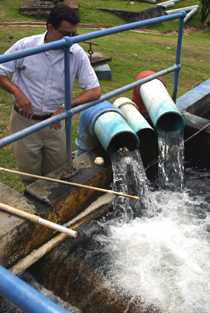Water Safety Plans
This information is provided by the National Center for Environmental Health’s Environmental Health Services Branch for informational and historical purposes. The GWASH function is now in another CDC organizational unit. This information is not maintained and may no longer be current and/or accurate.
Fact Sheet: Water Safety Plans: CDC's Role [PDF - 260 KB]
Success Story: Cleaner, Safer Water Through Water Safety Plans [PDF - 286 KB]
Working with public health partners, CDC’s Global Water, Sanitation, and Hygiene program promotes, designs, participates in, and evaluates environmental public health service programs to prevent and control diseases related to water supplies, sanitation, and poor hygiene practices.
A Water Safety Plan (WSP) is a holistic, systematic, and integrated management approach used to identify and prioritize potential threats to water quality at each step in a specific system’s water supply chain—from catchment to consumer—and implement best practices to mitigate those threats and ensure drinking-water quality.
WSPs are a key component of the framework for safe drinking water described in the World Health Organization’s Water Safety Plan Manual: Step-by-step risk management for drinking-water suppliers.
WSP Objectives and Benefits

A WSP aims to help drinking-water providers and other stakeholders improve water quality and consistently meet established health-based targets by
- controlling the contamination of source waters through managing activities in the watershed;
- optimizing the removal or inactivation of contaminants during treatment; and
- preventing recontamination during distribution, storage and handling.
The WSP approach to ensuring a safe water supply is flexible and serves to
- identify opportunities for low-cost improvements to operations and management practices that can enhance water safety;
- improve efficiency and reduce expenses;
- improve stakeholders’ understanding of the complete water supply chain and its vulnerabilities;
- improve communication and collaboration between key stakeholder groups, such as water providers, consumers, regulatory authorities and commercial, environmental and health sectors; and
- help substantiate and prioritize capital improvement needs and help leverage financial support.
WSP Framework
![Image of the framework for Safe Drinking Water that includes a Water Safety Plan with three key components: system assessment, operational monitoring, and management plans. Health-based targets guide these three components of the Water Safety Plan and drinking-water supply surveillance oversees them. [Figure courtesy of WHO]](images/wsp_framework.jpg)
Growing Worldwide Application of WSPs
Communities in almost every region of the world have implemented WSPs, including Africa, the Americas, Southeast Asia, Europe, and the Western Pacific. In the Latin America and Caribbean Region, pilot WSPs—many with the participation of CDC—have taken place or are in progress in the following locations:
- Buenos Aires, Argentina
- Tarija, Bolivia
- Vicosa, Brazil
- Linden, Guyana
- San Pedro Sula, Honduras
- Spanish Town, Jamaica
- Mabouya Valley, St. Lucia
- Dolores, Uruguay
In addition, CDC is engaged with various partners, including WHO, the Pan-American Health Organization (PAHO), the International Water Association (IWA), and the Inter-American Society of Sanitary and Environmental Engineers (AIDIS) in creating a regional network to support implementation of WSPs.
Related Links
World Health Organization
- Water Safety Portal - How to develop and implement a Water Safety Plan
- Water Safety Plan Manual: Step-by-step risk management for drinking-water suppliers (Also available in Spanish)
- Guidelines to Drinking Water Quality (4th edition) – Chapter 4
For publications on CDC’s Water Safety Plan program, visit Water Safety Plans Publications.
Top of Page- Page last reviewed: July 12, 2011
- Page last updated: June 28, 2016
- Content source:


 ShareCompartir
ShareCompartir